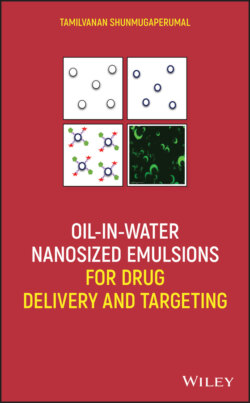Читать книгу Oil-in-Water Nanosized Emulsions for Drug Delivery and Targeting - Tamilvanan Shunmugaperumal - Страница 28
2.2.1. Issues Related to Oil Selection to Make the O/W Nanosized Emulsions for Medical Application
ОглавлениеIn general, the o/w nanosized emulsion should be formulated with compatible vehicles and additives. The components of internal (dispersed oil droplets) and external (aqueous continuous medium) phases of nanosized emulsions should be chosen to confer enhanced solubility and stability to the incorporated therapeutically active lipophilic API. In principle, the function of selected excipients should not only be limited to improve the overall physical stability of the emulsions or enhance the API's solubility but also they should contribute to influence the biofate or therapeutic index of the incorporated API after administration via parenteral, ocular, percutaneous, and nasal routes. The general considerations concerning excipient selection and optimum concentrations mainly in relation to the oils, emulsifiers, and miscellaneous excipients are presented comprehensively below.
At the time of preformulation studies, the solubility data of APIs need to be generated in the different oil selected, that too either alone or in combination of one oil with other oils in a definite ratio. Two more important points should be kept in mind before selecting the oil or oil combination. First point is compatibility of the oil or oil combination not only with other formulation excipients but also with the site of applications, i.e., ocular/skin tissues. Second point is related to auto‐ or self‐oxidation potential of oil or oil combination during and after emulsion manufacturing, because oils are triglycerides and are prone to auto‐ or self‐oxidation over the emulsion's processing and storage time periods. To minimize or to eliminate some extent the auto‐ or self‐oxidation, the additional excipient recommended to include in the emulsion formula is antioxidants, especially α‐tocopherol in the concentration range from 0.001 to 0.002% w/w.
The final oil‐phase concentration in emulsions meant for ocular use is now widely accepted to be at or below 5% w/w taking into account that the emulsion must be kept in a low‐viscosity range of between 2 and 3 centipoises, which also is the optimal viscosity for ocular preparations (Lee and Robinson 1986). This viscosity range may be suitable to take the emulsion into the syringe (i.e., syringeability) for parenteral application into human body. However, for all other medical uses, the amount of oil may be varied but generally is within 5–20% w/w. Sometimes, a mixture of oils may be employed to facilitate API solubilization in the oil phase. Jumaa and Müller (1998, 1999) reported the effect of mixing castor oil with medium‐chain triglycerides (MCT) on the viscosity of castor oil. Mixing of castor oil with MCT at a ratio of 1 : 1 (w/w) led to a decrease in the viscosity of castor oil and simultaneously to a decrease in the interfacial tension of the oil phase. The presence of free fatty acids in the castor oil (may be as an impurity) can act as coemulsifiers to lower the interfacial tension between dispersed oil droplets and continuous aqueous medium and subsequently to produce a more stable emulsion formulation in comparison with the other oil phases. In addition to the digestible oils from the family of triglycerides, including soybean oil, sesame seed oil, cottonseed oil, and safflower oil, which are routinely used for making medical emulsions, alternative biocompatible ingredients such as α‐tocopherol and/or other tocols were also investigated for API delivery purposes via o/w emulsions (Constantinides et al. 2004, 2006). But the emulsions formed from tocols are often considered as microemulsion systems with few exceptions (Constantinides et al. 2004, 2006). Very recently, it was shown that playing with oil combinations could generate the dispersed oil droplets with bi‐compartmental structure possessing different polarity and thus paving the strategy of dual API loading in the o/w macro‐ and nano‐sized emulsions (Puri et al. 2019). The details of this type of emulsions are discussed in Chapter 7.
